Table of contents
- Comparison test gasoline consumption Panigale, NC 700, Trophy and Z 1000 SX in the consumption test
- Minimal consumption on the country road requires getting used to
- Shifting lazy gliding with the BMW F 800 R.
- Tires and chassis can spoil the joy of saving fuel
- Panigale requires a lot of gearshift work and clutch use
- Honda NC 700 S is the world champion in terms of economy
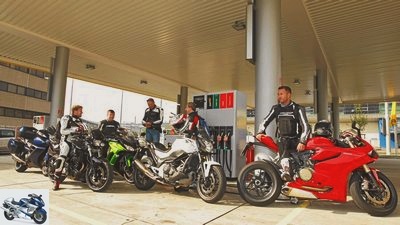
Bilski
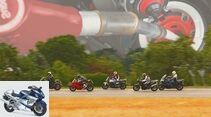
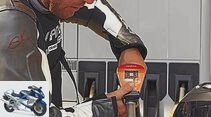
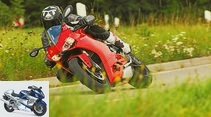
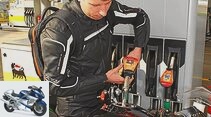
41 pictures
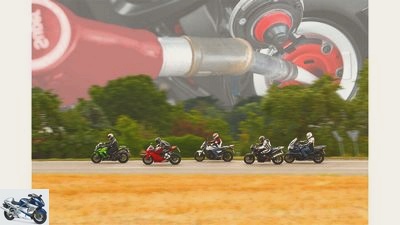
Bilski
1/41
If you only take your motorcycle out of the garage on Sundays, you don’t care about the fuel consumption of your two-wheeler. But don’t you also find it exciting what an Italian high-performance engine nipples away at full throttle on the “German Autobahn”? Or how far you can get with the fuel-saving Primus Honda NC 700 S with a careful driving style? MOTORRAD got the answers.
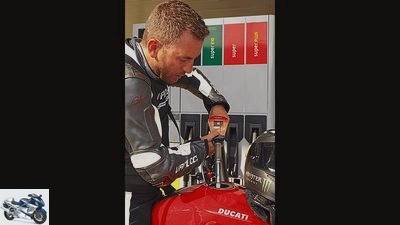
Bilski
2/41
… Data: Two-cylinder four-stroke 90-degree V-engine, bore x stroke 112.0 x 60.8 mm, displacement 1198 cm³, rated power 143.0 kW (195 PS) at 10 750 / min, max. Torque 132 Nm at 9000 rpm, weight with a full tank 195 kg, tank capacity / reserve 17.0 / 2.0 liters, price including ancillary costs 19995 euros.
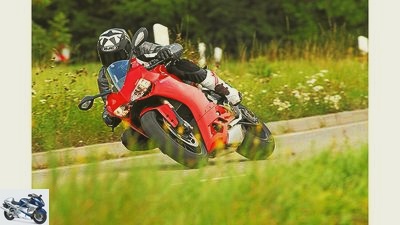
Bilski
3/41
Ducati 1199 Panigale: Minimal consumption of 5.0 liters.
16 liters on 100 kilometers of full throttle drive – that’s something of flat-rate drinking! A so-called full throttle enrichment is responsible for this value. Because measured by the displacement, the fat piston diameters and the power, the minimum consumption of five liters per 100 km is really impressive …
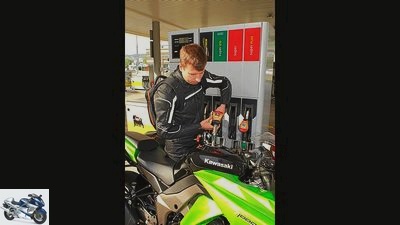
Bilski
4/41
… Data: four-cylinder four-stroke in-line engine, bore x stroke 77.0 x 56.0 mm, displacement 1043 cm³, rated output 101.5 kW (138 hp) at 9600 / min, max. Torque 110 Nm at 7800 / min, weight fully fueled 231 kg, tank capacity 19.0 liters, price including ancillary costs 13,420 euros.
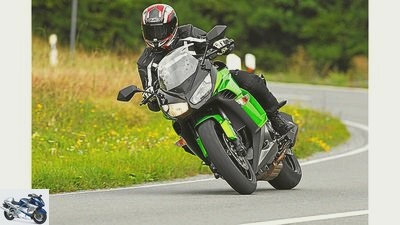
Bilski
5/41
Kawasaki Z 1000 SX: Minimal consumption 4.8 liters.
The high-speed offshoot of the Z 1000 is particularly popular with performance enthusiasts with its powerful drive and short gear ratio. However, the high speed level is reflected in the consumption. Even if the Kawa is not a drunkard: 14 liters per 100 kilometers can be scolded thirstily. The minimum consumption is okay …
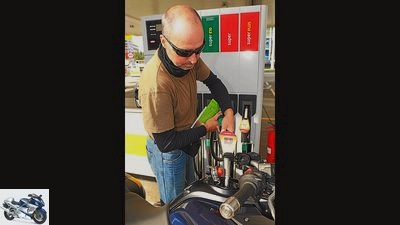
Bilski
6/41
… Data: three-cylinder four-stroke in-line engine, bore x stroke 85.0 x 71.4 mm, displacement 1215 cm³, rated output 99.0 kW (135 PS) at 8900 / min, max. Torque 120 Nm at 6450 / min, weight fully fueled 303 kg, tank capacity 26.0 liters, price including ancillary costs 19,040 euros.

Bilski
7/41
Triumph Trophy: Minimal consumption 4.5 liters.
At 303 kilograms, the British woman is a tough job. The consumption values are all the more astonishing. With an optimized driving style, less than five liters are not rocket science, and the 1200 cubic meters do not burn an indecent amount even on the highway. The Trophy’s aerodynamics seem to be better than expected …
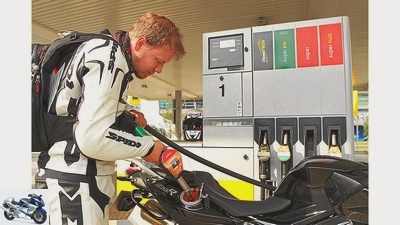
Bilski
8/41
… Data: Two-cylinder four-stroke in-line engine, bore x stroke 82.0 x 75.6 mm, displacement 798 cm³, rated power 64.0 kW (87 PS) at 8000 / min, max. Torque 86 Nm at 6000 / min, weight fully fueled 212 kg, tank capacity / reserve 16.0 / 4.0 liters, price including ancillary costs 9290 euros.
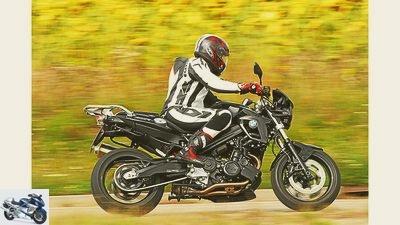
Bilski
9/41
BMW F 800 R: If you put the power of the engine in relation to fuel consumption, you can’t get past the F 800 from Bavaria. The 87 hp are enough for a speed of 220 km / h, and even there the BMW remains below the ten-liter mark. Anyone to whom gasoline consumption is just as important as driving dynamics drives the F 800 …
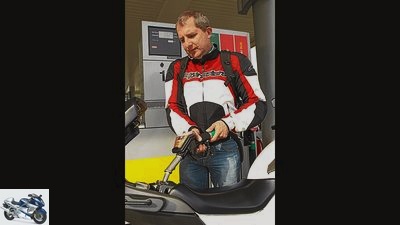
Bilski
10/41
… Data: Two-cylinder four-stroke in-line engine, bore x stroke 73.0 x 80.0 mm, displacement 670 cm³, rated output 35.0 kW (48 PS) at 6250 / min, max. Torque 60 Nm at 4750 / min, weight fully fueled 215 kg, tank capacity 14.1 liters, price including ancillary costs 5995 euros.

Bilski
11/41
Honda NC 700 S: Minimum consumption 2.8 liters.
The consumption minimalist carries his 14-liter keg under the seat and is refueled from there. Great, how economical the in-line two-cylinder works. Even with brisk country road chasing, the 48-hp planer allows itself under four liters – and that despite the high proportion of full load, in order to stick to the other bikes …
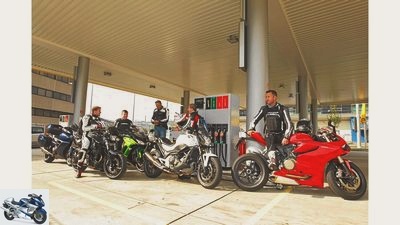
Bilski
12/41
All five vehicles are at the pump. The moment of truth has struck.
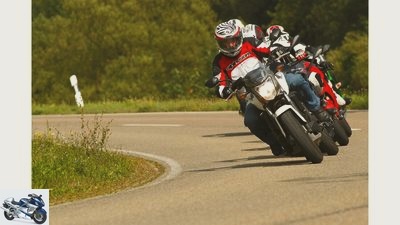
Bilski
13/41
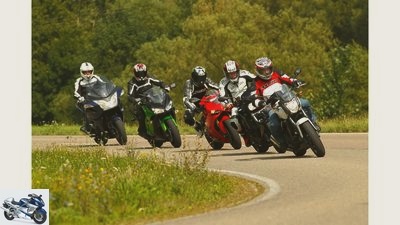
Bilski
14/41
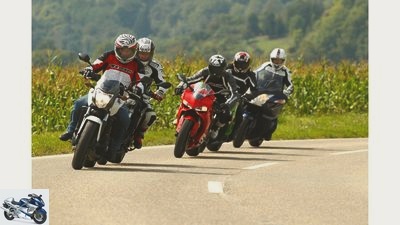
Bilski
15/41
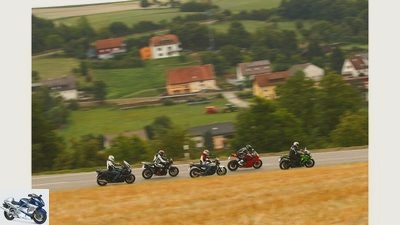
Bilski
16/41

Bilski
17/41
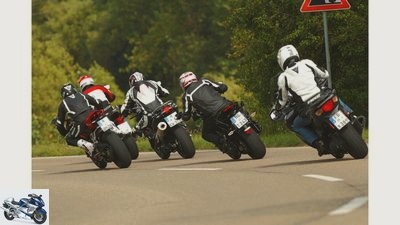
Bilski
18/41
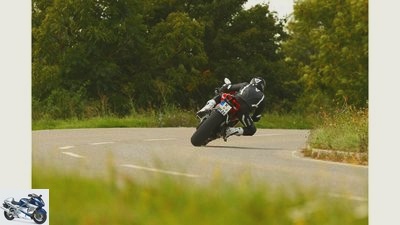
Bilski
19/41
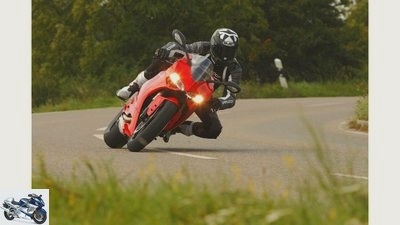
Bilski
20/41
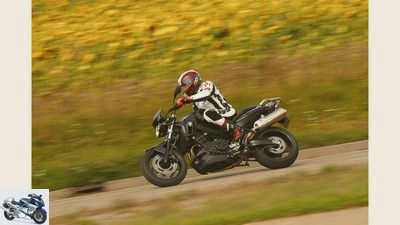
Bilski
21/41

Bilski
22/41
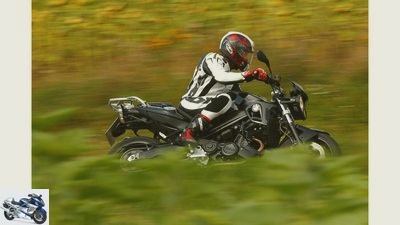
Bilski
23/41
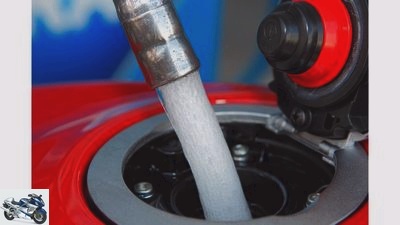
Bilski
24/41
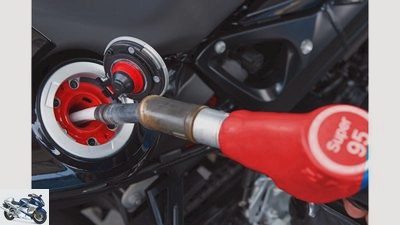
Bilski
25/41
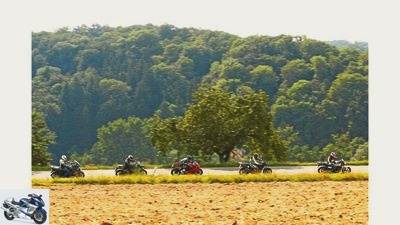
Bilski
26/41
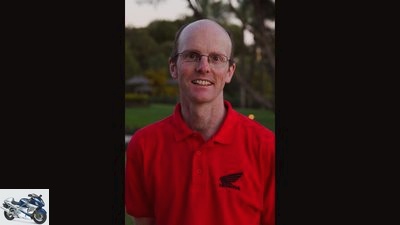
Bilski
27/41
Paul Nowers, PR Manager at Honda Motor Europe, sees a rethinking among buyers of motorcycles: towards more economical bikes that are more suitable for everyday use.
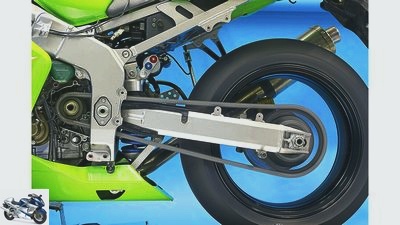
Bilski
28/41
Final drive: Regardless of whether it is a chain or a cardan shaft, the power flow to the rear wheel costs around 3% power, depending on the condition and construction.

Bilski
29/41
Ducati 1199 Panigale: When the reserve lamp lights up, it means: urgently refill, only two liters left on board!
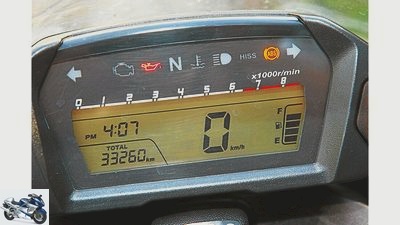
Bilski
30/41
Honda NC 700 S: As roughly as Hungarian salami: The last bar starts to flash, there are still four liters in the tank.
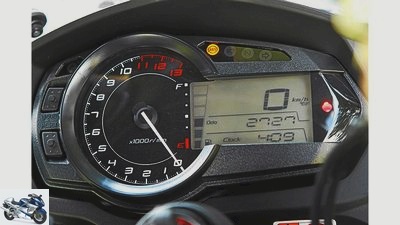
Bilski
31/41
Kawasaki Z 1000 SX: If only the last of the six lines is displayed, 2.5 liters remain. That fits!
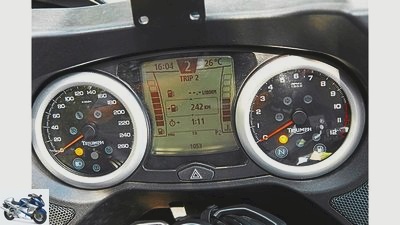
Bilski
32/41
Triumph Trophy: All credit to the luxury tourer: the driver is reliably informed of the range that is accurate to the kilometer. That’s how it should be.
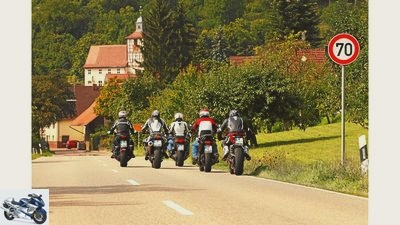
Bilski
33/41
Who brakes, consumes! So always drive with foresight, take off the accelerator early and let it roll.
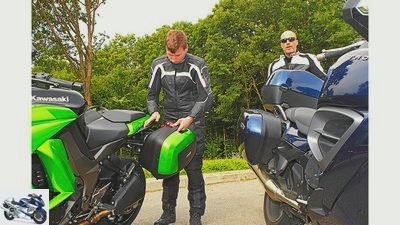
Bilski
34/41
Do you really need the suitcase and topcase for the tour on Sunday? If not: lose weight!
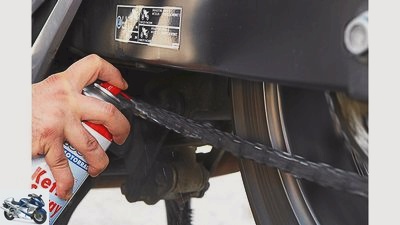
Bilski
35/41
The drive chain must be checked for tension and adequate lubrication. Correct if necessary.

Bilski
36/41
On long stretches of the motorway, the air pressure should be increased to the maximum permitted level.
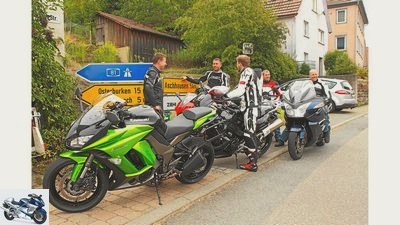
Bilski
37/41
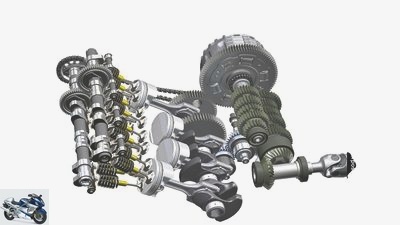
Bilski
38/41
Depending on the engine design, load and speed, the energy used is consumed by waste heat and friction from the moving engine components.
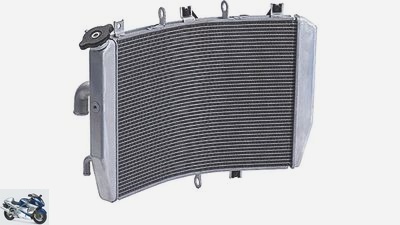
Bilski
39/41
Waste heat through exhaust and cooler:
Up to 35% of the energy disappears in the exhaust gas, around 25% via the cooler and surface radiation.
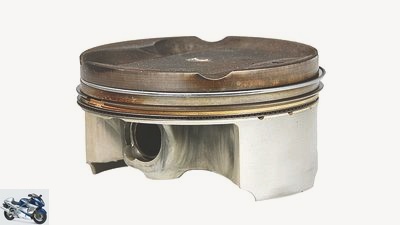
Bilski
40/41
Piston: Due to mixture residues in the piston ring zones and excessively rich mixture on the top land, 5 to 20% of unburned gasoline residues disappear in the exhaust.
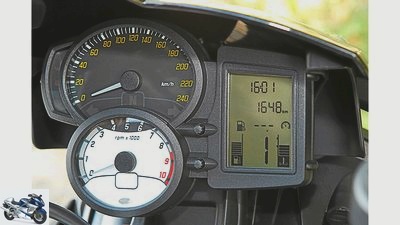
Bilski
41/41
BMW F 800 R: Four liters of reserve capacity means a range of just under 100 kilometers for the BMW. Too much of!
motorcycles
Comparison test gasoline consumption
Comparison test gasoline consumption
Panigale, NC 700, Trophy and Z 1000 SX in the consumption test
Don’t you also find it exciting what an Italian high-performance engine nipples away at full throttle on the “German Autobahn”? Or how far can you get with the fuel-saving Primus Honda NC 700 S with a careful driving style? MOTORRAD has the answers.
Roman Kirschbauer
09/12/2013
Exactly 103 kilometers. Then the engine stops. Don’t lose any momentum now and reach the next parking lot in two kilometers! The airstream remains deafening, energetically pulling on all parts of the body. The speedometer still shows over 200 km / h. the Ducati 1199 Panigale rolls out slowly – if you can even call it that at this speed. A few minutes later at the gas station the unshakable truth follows: over 16 liters of premium gasoline go into the tank. That makes a consumption of 15.9 liters per 100 kilometers. This would prove the Italians’ ability to drink. the Ducati To put it in a bad light for that reason alone would be more than unfair. So let’s start the story all over again:
Buy complete article
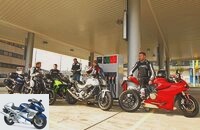
Comparison test gasoline consumption
Panigale, NC 700, Trophy and Z 1000 SX in the consumption test
10 pages) as PDF
€ 2.00
Buy now
The fuel consumption of motorcycles has always been a pretty exciting thing – even if it is clear that nobody falls in love with a bike because it is stingy with the precious fuel. Most use the moped exclusively as a leisure device and enjoy the lonely hours on country roads that look like late summer. Who cares whether the thing chases five or six liters per 100 kilometers through the combustion chambers?
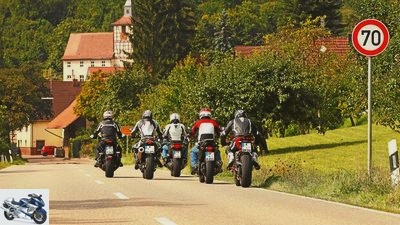
Bilski
Who brakes, consumes! So always drive with foresight.
Everything is right. However, the subject should not be neglected. After all, you get annoyed at the gas station when you spend 30 euros over the counter for a single time or when you have to keep looking for the next gas pump due to a lack of reasonable range.
But what do current motorcycles actually consume if you drive them as sparingly as the two-liter petrol engine
Family carriage? Or when you squeeze it out like a lemon and always drive a full bottle? Motorcycles drove on a big fuel-consumption trip, covered a total of 2,500 kilometers with five candidates in three disciplines, which corresponds to a distance from Flensburg to the tip of Italy’s boot. Before we start, the tire pressure is corrected to the manufacturer’s recommendation, chain tension and lubrication are checked, and the tester’s suitcases, top cases and backpacks are loaded into the support vehicle.
Minimal consumption on the country road requires getting used to
The first task is also the trickiest and requires the most getting used to. The minimum consumption over the country road is carried out according to exact specifications. In concrete terms, this means: always low engine speeds, early upshifts, not exceeding the maximum permitted speed and overall a forward-looking, smooth driving style. In addition: if you anticipate a reduction in speed, take your foot off the accelerator in good time and take advantage of the roll phase. Braking is only applied when it is really necessary. Does it all sound terrible? It’s not that bad at all!
The driver on the Honda NC 700 S with its long-stroke two-cylinder engine has a good laugh in this discipline.
For the high-torque drive, low-rev driving is easy. Even at 1500 revolutions and the cock cocked, it doesn’t chop on the chain or choke, but turns in a very disciplined manner up to just over 2000 revs. Clack, clack, clack – you have already reached 50 km / h in the last gear and easily follow your comrades in spite of the smallest peak performance. Due to the nimble handling, this driving style on the Honda does not feel at all hard or even tough, fits the smallest of cubic capacities like a fist in the eye. But whether this driving style can still reduce your already known low fuel consumption? We will see.
Shifting lazy gliding with the BMW F 800 R.
Now it’s time for the BMW F 800 R to hit the collar. The Bayern twin is fully in the juice with its nominal 87 hp. Nobody needs more horses on the country road. Especially since this 798 cubic centimeter two-cylinder starts with a lot of torque and pushes the easy-to-steer roadster forward from idle. No whipping of the chain, no parallel-twin stuttering when the gas tap is opened and the engine speed is low. The short translation also enables lazy shifting in the last gear.
What applies to the Honda, BMW can also write itself on the flags. The consumption-optimized, round driving style in no way spoils the driving pleasure on either vehicle. Both fold willingly in an inclined position, can be playfully folded down and straightened up again. So you always lose little momentum and can keep third or fourth gear engaged even in tight corners. If you concentrate on what you are doing and choose a good line, you will never become a traffic obstacle.
Amazingly, this also applies to the sumo wrestler among the local test candidates. The British three-cylinder in the Triumph Trophy has been tough to haul. After all, the 303 kilograms (without suitcase) need to be set in motion. It’s good that the 1200 cubic centimeters of combustion chamber already make it possible to get a lot of steam and early upshifts from 1000 revs. In contrast to the F 800 R and NC 700 S, the Trumm requires an experienced driver in order to be folded up and down on winding country roads, but the great accuracy always enables driving on the ideal line.
Tires and chassis can spoil the joy of saving fuel
For the touristy athlete in the league, the Kawasaki Z 1000 SX, that should also apply. Especially since its four-cylinder in-line engine is known for a lot of pressure from below, despite its sporty genes. In the case of the Kawa, however, it becomes clear to what extent tires and chassis can spoil the joy of saving fuel. The test copy is reluctant to bring it into line and has to be kept on course with a lot of pressure on the handlebars. This not only stresses the driver, but also ensures that you intuitively take off the accelerator a tad sooner before cornering and prefer to run through them more defensively. It is logical that the gas has to be opened more at the apex in order to stay close to the opponent. And something else stands out: the extremely short translation of the Z 1000 SX ensures a consistently high speed level, so the driver can look in vain for a seventh gear.
Panigale requires a lot of gearshift work and clutch use
That is not the case with the 195-horsepower Ducati Panigale rocket. The Desmo-Twin has other worries. Not only do you crouch down, as expected, and too extreme for the country road on the box. The pistons, each with a diameter of 112 millimeters, do not like low speeds at all. Below 3000 tours, the chain is badly strained and the driver is shaken by jarring vibrations. In this discipline, the red diva requires a lot of gearshift work and use of the clutch. A great athlete on a fuel diet is no picnic. That was expectable.
All five vehicles are at the pump. The moment of truth has struck: With no less than five liters per 100 km, the efforts on the Panigale have paid off. Especially when you put the consumption in relation to the potential of this high-performance engine. Those who move the Italian sparingly can travel up to 340 kilometers at a time: Bravo! Kawa and Triumph need 0.2 and 0.5 liters less, which is surprising, at least in the case of the Triumph. Her high weight does not seem to have a negative impact. In extreme cases, their 26 liters of petrol are enough for the route from Cologne to Berlin. Non-stop. You need leather skin on your buttocks.
Honda NC 700 S is the world champion in terms of economy
BMW and Honda present themselves as real refusal to consume. What already felt like this while driving is confirmed when refilling. With 3.7 liters, the BMW remains the first choice when it comes to sufficient performance with restrained drinking habits. The NC 700 S became the world champion in terms of economy, however. It only sniffs a fantastic 2.8 liters through its combustion chambers. And compared to a car, you are still much faster with this driving style and still have to go to the gas station almost as rarely as a small car. The NC 700 S drives over 500 kilometers in one go – with only 14.1 liters in the tank: great!
The test team, some of them a little tired, wakes up again during the brisk lap of the country road that follows. With strong intermediate sprints and harder braking maneuvers, the driving pleasure and dynamics increase immensely. Kawasaki, Triumph and Ducati really come to life here, while the Honda with its 48 hp is already close to its performance limit. However, this has no influence on the placement in the consumption list. The additional consumption is between 0.9 and 1.7 liters, but the mood of the driver increases at least three times. The fact that with a consumption-optimized driving style you can save around 25 percent fuel on each of the motorcycles compared to brisk driving is more than some had expected. What if you’re in a hurry? Then you should allow enough time to refuel! Because what can be laboriously saved downwards can easily be fired out again within a very short time under full load. But how much exactly?
Related articles
-
Practical test: gasoline consumption
counselor workshop Practical test: gasoline consumption Practical test: gasoline consumption Consumption advice Work makes you thirsty. That applies to…
-
Gasoline consumption of motorcycles
Tyson Jopson 13th pictures Tyson Jopson 1/13 What is the current state of affairs in terms of fuel consumption? A series of experiments. Tyson Jopson…
-
Comparison test Honda CBF 1000 F and Suzuki Bandit 1250 S
Bilski 32 pictures Bilski 1/32 The CBF 1000 F looks more elegant, dignified, sleeker. The 1250 Bandit comes across as beefier, more powerful with a more…
-
Mid-range crossover bikes in a comparison test
www.factstudio.de 32 pictures www.factstudio.de 1/32 Pepped up: The Honda NC 750 X was the only bike in the test field to be revised for this year……
-
Gargolov motorcycles Comparison test: big bikes Comparison test: Big Bikes from Honda and Suzuki Test: Honda CBF 1000 F, CB 1300 S and Suzuki Bandit 1250…
-
Artist 48 pictures Artist 1/48 Four inexpensive motorcycles have appeared in the south of France … Artist 2/48 Artist 3/48 The winner of the 1000-point…
-
Comparison test: 600cc extreme athlete
K motorcycles Comparison test: 600cc extreme athlete Comparison test: 600cc extreme athlete Spear tips Content of They flaunt long lances at the end, are…
-
Comparison test: 600s in a quintet
Jahn motorcycles Comparison test: 600s in a quintet Comparison test: 600s in a quintet Toys Content of The middle class is burning brightly! The…
-
Comparison test MV Agusta Turismo Veloce 800 and Yamaha MT-09 Tracer
Bilski 19th pictures MOTORCYCLE 1/19 Power on the crankshaft. Measurements on the Dynojet roller test stand 250, corrected according to 95/1 / EG,…
-
Comparison test: Japanese naked bikes
Jahn motorcycles Comparison test: Japanese naked bikes Comparison test: Japanese naked bikes Go big Content of …or go home! Big bore instead of boring,…